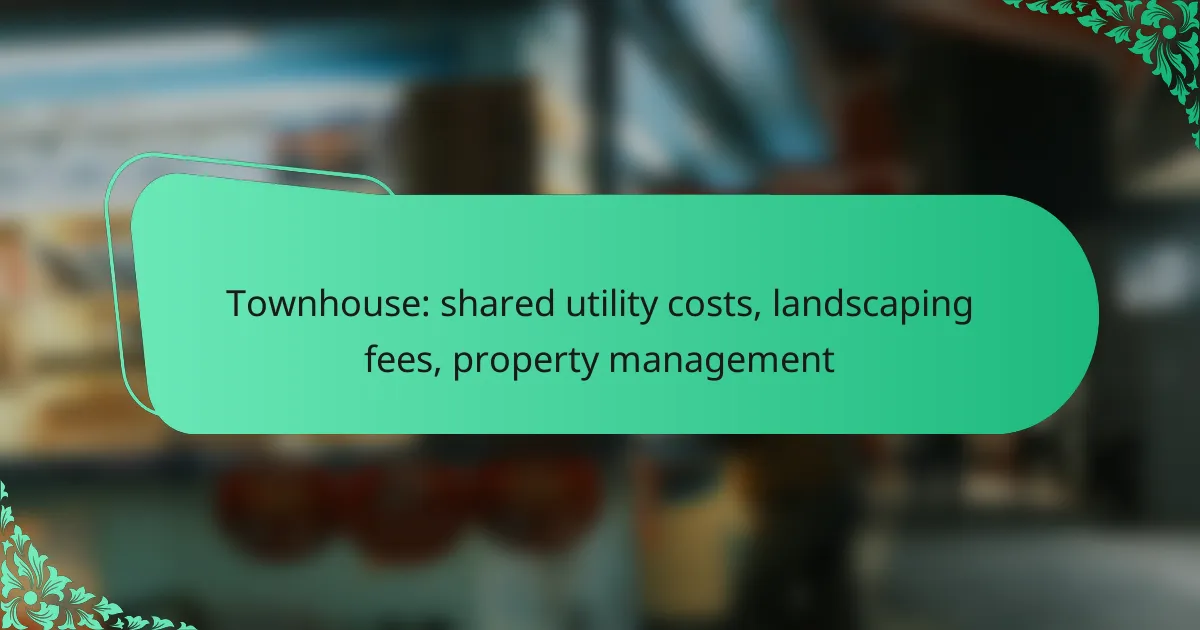In townhouse communities, shared utility costs encompass essential services like water, electricity, and gas, which are divided among residents. Additionally, homeowners should be aware of landscaping fees that fund the upkeep of communal outdoor areas. Effective property management is vital, as it ensures the smooth operation of these shared expenses and compliance with community standards.

What are shared utility costs in townhouses?
Shared utility costs in townhouses refer to the expenses for essential services that are collectively used by residents, such as water, electricity, and gas. These costs are typically divided among all homeowners in the community, making it crucial for residents to understand how these expenses are calculated and managed.
Common utilities included
Common utilities in townhouse communities often encompass water, electricity, gas, and sometimes internet or cable services. Each of these utilities contributes to the overall living experience and can vary significantly based on usage and local rates.
In some cases, homeowners’ associations (HOAs) may also include trash collection and recycling services in the shared utility costs. Understanding which utilities are covered helps residents budget effectively.
How costs are divided
Costs for shared utilities are usually divided based on the number of units in the townhouse community or the square footage of each unit. This ensures that each homeowner pays a fair share relative to their usage and property size.
Some communities may implement a tiered system where larger units pay more, while smaller units pay less. It’s essential for residents to review their HOA agreements to understand the specific formula used for cost allocation.
Impact on monthly fees
Shared utility costs can significantly impact monthly fees for townhouse residents, often adding a few hundred dollars to the total. Depending on the community and the utilities included, these fees can fluctuate seasonally, especially for heating and cooling expenses.
Residents should be aware of these costs when budgeting for their monthly expenses. Regular communication with the HOA can provide insights into any anticipated changes in utility fees and help residents plan accordingly.

What landscaping fees should townhouse owners expect?
Townhouse owners can anticipate landscaping fees that cover maintenance and enhancement of shared outdoor spaces. These fees typically vary based on the services provided and the size of the community.
Typical landscaping services
Common landscaping services for townhouse communities include lawn care, tree trimming, flower bed maintenance, and seasonal clean-ups. Some communities may also include irrigation system upkeep and pest control as part of their landscaping package.
These services ensure that shared areas remain aesthetically pleasing and functional, contributing to the overall value of the property. Regular maintenance is crucial to prevent overgrowth and maintain a welcoming environment.
Cost-sharing arrangements
Landscaping fees are usually shared among townhouse owners, with costs divided based on the number of units or square footage of the property. This arrangement helps distribute expenses fairly and ensures that all owners contribute to the upkeep of common areas.
Some communities may opt for a flat fee per unit, while others might calculate costs based on usage or specific services rendered. It’s essential for owners to understand their community’s approach to cost-sharing to avoid disputes.
Factors influencing fees
Several factors can influence landscaping fees, including the complexity of services, the frequency of maintenance, and the size of the landscaped areas. More extensive services or larger properties will typically incur higher costs.
Additionally, regional labor rates and the types of plants or materials used can also affect pricing. Owners should review service contracts carefully to ensure they are getting value for their fees and consider comparing quotes from different landscaping companies.

How does property management work for townhouses?
Property management for townhouses involves overseeing the maintenance, finances, and overall operation of the townhouse community. This typically includes managing shared utilities, landscaping fees, and ensuring compliance with community regulations.
Role of property management companies
Property management companies serve as intermediaries between townhouse owners and residents, handling day-to-day operations. They coordinate maintenance requests, enforce community rules, and manage financial aspects such as collecting dues and paying bills.
These companies often provide expertise in managing shared resources, ensuring that costs for utilities and landscaping are fairly allocated among residents. Their role is crucial in maintaining property values and community satisfaction.
Common management fees
It’s important for townhouse owners to review the fee structure carefully, as some companies may charge extra for services like emergency repairs or tenant placement. Understanding these costs helps in budgeting effectively for community expenses.
Benefits of professional management
Hiring a professional property management company can lead to improved efficiency and better maintenance of shared areas. They have the resources and expertise to handle issues quickly, which can enhance resident satisfaction.
Additionally, professional management can help in maintaining compliance with local regulations and community standards, reducing the risk of legal issues. This proactive approach can ultimately protect property values and foster a harmonious living environment.

What are the criteria for choosing a property management service?
Choosing a property management service involves evaluating their experience, reputation, and the range of services they offer. It’s essential to find a company that aligns with your specific needs and can effectively manage shared utility costs, landscaping fees, and other responsibilities.
Key factors to consider
When selecting a property management service, consider their experience in managing townhouses and similar properties. Look for companies that have a proven track record of handling shared utility costs and maintaining common areas, as these are critical aspects of townhouse management.
Evaluate their communication style and responsiveness, as effective communication can significantly impact tenant satisfaction. Additionally, inquire about their fee structure to ensure it aligns with your budget, typically ranging from 5% to 10% of the monthly rent.
Local recommendations in London
In London, several property management companies come highly recommended for townhouse management. Look for firms that are familiar with local regulations and have experience managing properties in your specific borough.
Consider checking online reviews and asking for referrals from other townhouse owners in your area. Companies like Foxtons and Savills are well-known, but smaller, local firms may offer more personalized service and competitive rates.

What are the advantages of shared services in townhouses?
Shared services in townhouses provide significant benefits, including reduced costs and enhanced community living. By pooling resources, residents can enjoy lower utility bills and maintenance fees while fostering a sense of belonging among neighbors.
Cost efficiency
Cost efficiency is a primary advantage of shared services in townhouses. By dividing utility costs, such as water, electricity, and internet, among multiple households, residents can significantly lower their monthly expenses. For instance, instead of each unit paying for individual landscaping or maintenance, these costs can be shared, often resulting in savings of 20-30% per household.
Additionally, shared services can lead to bulk purchasing discounts for common supplies and services, further enhancing savings. It’s essential for residents to regularly review and negotiate contracts for shared services to ensure they are receiving the best rates possible.
Community benefits
Shared services foster a stronger sense of community among townhouse residents. When neighbors collaborate on landscaping or maintenance, it encourages interaction and builds relationships, creating a more cohesive living environment. Community events can also be organized around these shared services, enhancing social ties.
Moreover, shared responsibilities can lead to improved property upkeep. When residents are invested in the maintenance of common areas, such as gardens or recreational spaces, the overall aesthetic and functionality of the community improves, benefiting everyone involved.

What are the challenges of shared utility costs?
Shared utility costs in a townhouse can lead to various challenges, primarily due to differing consumption patterns and the potential for disputes among residents. Understanding these issues is essential for maintaining harmony and ensuring fair financial management.
Disputes among residents
Disputes often arise when residents disagree on how utility costs are calculated or allocated. For example, if one household consistently uses more water or electricity, others may feel they are unfairly subsidizing that usage. Clear communication and established guidelines can help mitigate these conflicts.
To prevent disputes, consider implementing a transparent billing system that outlines how costs are divided. Regular meetings to discuss utility usage and expenses can also foster understanding and cooperation among residents.
Variable usage impacts
Variable usage among residents can significantly affect shared utility costs. For instance, families with children may consume more water and electricity compared to single occupants. This disparity can lead to frustration if costs are not adjusted accordingly.
One approach to address variable usage is to adopt a tiered billing system, where higher usage incurs a higher rate. This method encourages conservation and ensures that those who use more pay a fair share. Additionally, residents should be encouraged to adopt energy-efficient practices to help reduce overall costs.










